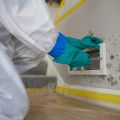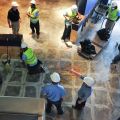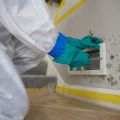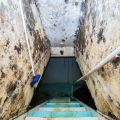How to Limit Mold Growth in Your Business after Flood in Georgia

Flooding events pose extensive problems for business owners. Without fast action, acquired water damage can significantly affect building materials and equipment as well as cause severe issues including mold development.
1. Complete Water Removal and Drying
- Perform water extraction and structural drying as soon as possible to prevent mold spores from growing.
- Use a wet-dry shop vacuum to remove water.
- Clean materials like exposed wood framing and studs and maintain healthy ventilation inside the area with open doors and windows.
2. Remove Items Infested with Mold
- Items that have been completely submerged in water should be discarded. However, items like books and paper, upholstery and drapery can potentially be saved.
- A material that has been wet for less than 48 hours may be cleaned and disinfected to delay mold growth. If mold develops, however, the item must be disposed of immediately.
- Mold can grow in hidden areas such as behind drywall, within insulation and inside wall cavities. Remove contaminated porous materials (e.g. drywall, ceiling tiles) and wet insulation.
3. Control Moisture and Humidity
- If electricity is safe to use, turn on dehumidifiers and fans to reduce moisture in the affected area.
- Do not use fans if mold has already started developing. Moving air scatters mold spores throughout the environment.
4. Contact a Restoration Service Provider
- To effectively prevent mold growth after a flood, it is recommended to contact an experience restoration company to attend to the damage as soon as possible.
- Mold remediation specialists understand how to properly handle the situation and use the right equipment to remove mold and restore properties.
Items Susceptible to Mold Growth
Mold can start developing in as little as 24 to 48 hours after water damage, which is why preventative measures are crucial to limit growth. Items which may support mold growth after a recent flood include:
- Carpets, rugs and drapery: Mold growth prevention through drying may not be effective for carpets, drapery and rugs damaged by water. These items may need to be discarded.
- Upholstered furniture and wood: Porous materials like upholstery and wood easily trap mold and may have to be disposed of. Items that have been completely submerged in water should be replaced.
- Glass, plastic and metal: While mold can grow on these items, they can be salvaged with proper cleaning and disinfecting techniques.
Atlanta's Leading Mold Remediation Company
ServiceMaster of Cobb safely and effectively cleans and restores personal items affected by water damage and mold including books, documents, artwork, and more.
ServiceMaster of Cobb offers complete mold remediation services to residential and commercial properties in Atlanta, Georgia and the surrounding areas. We have been delivering prompt and professional responses to mold damage incidents since 1996.
Our mold remediation team removes the mold source, cleans affected surfaces and materials, recreates the conditions of penetration with appropriate counteractants or neutralizers, and seals restorable surfaces as necessary.
ServiceMaster of Cobb is an IICRC-certified firm with offices in Georgia and Tennessee. To discover more about our mold remediation services, call ServiceMaster of Cobb or connect with us online today.
- ServiceMaster of Cobb (Georgia): (678) 264-3310
- ServiceMaster Cleaning & Restoration (Tennessee): (423) 220-4482
- ServiceMaster Downtown Commercial: (678) 909-1078







